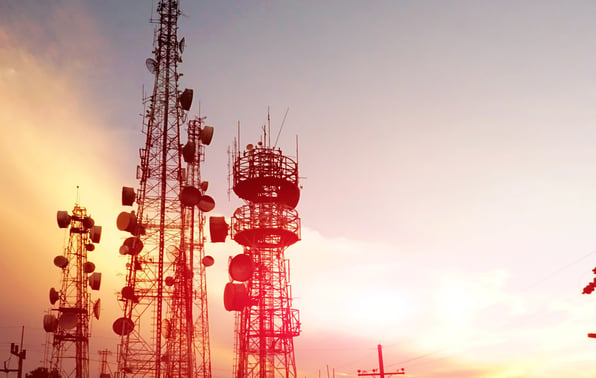

What is LPWAN
Amidst the surge of new technologies and high demand for digital transformation, IoT (Internet of Things) has revolutionised the IT ecosystem. The backbone of any IoT architecture is its reliable and efficient connectivity between the various devices that, include sensors, actuators and embedded systems. LPWAN- Low Power Wide Area Network is one of the most effective ways in which these devices can communicate with each other. In 2022, the LPWAN market exceeded USD 5 billion, and it is expected to grow exponentially by around 50% by 2032 because of the increased adoption of IoT and other embedded device solutions.
As the full name of LPWAN: Low Power Wide Area Network suggests, it commits to sending the data at long distances with less power consumption and minimum supervision required. The primary characteristics of LPWANs can be defined as their ability to operate with extended battery life, which can be between 10 to 15 years, while providing wide area coverage and low-cost mass device deployment solutions. LPWAN has become a number one choice for the IoT ecosystem with reliable and low-cost communication for Machine to Machine (M2M) and Machine to Cloud (M2C) applications.
In the last couple of decades, several LPWAN technologies have emerged, utilising both licensed and unlicensed frequency bands that are leveraged by different industries. The most widely used among them are Sigfox and LoRaWan- classified as non-cellular standards, and Narrowband IoT (NB-IoT), and Long Term Evolution (LTE-M) come under cellular standards. Next, in this article, these standards are introduced briefly. For a detailed account of these standards, refer to Different LPWAN Technologies Explained.
LoRaWAN
LoRaWAN, devised by the LoRa Alliance, is an architecture that is based on an open standard. LoRaWAN does not only stand out because it’s an excellent option for long-range and energy-conserving transmissions, but also because of its hybrid nature. It can use LoRa gateway to offer Local Area Networks (LAN) and can work with base stations for public network operations.
Sigfox
Sigfox is also an open LPWAN standard which can operate as both, a network operator and a technological standard. It utilizes an ultra-narrow band thus, optimizing it's frequency bandwidth usage; which results in minimal power consumption, heightened receiver sensitivity, and cost-effective design while maintaining its maximum throughput.
LTE-M
LTE- M is a 3rd generation partnership project (3GPP) standard operating within the licensed LTE frequency spectrum. In contrast to LTE networks, LTE-M provides extended coverage and a smooth transition towards 5G M2M solutions. The latest version of LTE is LTE Cat-M1 technology that facilitates massive machine-type communications (mMTC) and ultra-low-power wide-area network (uLPWAN) applications. It caters to the devices with long battery life and low data rate requirements, for example, smart meters, asset trackers, and various Industrial Internet of Things (IIoT) devices.
Narrowband IoT (NB-IoT)
Like LTE, NB-IoT was also introduced by 3GPP in June 2016. It is an IoT technology operating on narrow-band frequencies. It has the capability to coexist with GSM (Global System for Mobile Communications) and LTE (Long-Term Evolution) within licensed frequency bands. The strength of NB- IoT lies in its cost efficiency and lower energy consumption. It is primarily because the NB- IoT is based on an already existing LTE communication protocol. The NB- IoT, therefore, can manipulate the functionalities of LTE protocol as required by the IoT application. In addition, the NB- IoT can be easily integrated via a software upgrade with the LTE infrastructure.
Choosing one among many LPWAN standards or utilising LPWAN for a particular IoT system depends on the application for which the system is being designed.
Nonetheless, LPWANs assist massive IoT applications, also known as mMTC, for smart cities, Healthcare, smart agriculture, retail, manufacturing, transportation etc. LPWANs can be employed for nearly all sectors of industry and society. To learn more about its use cases and various applications, refer to “Use-cases of LPWAN: Exploring the landscape of LPWAN applications”.
What is the future of LPWAN?
It's worth noting that LPWAN standards continue to evolve, and new updates and enhancements are continuously being introduced since their initial development. Generally, the sustainable and scalable nature of LPWAN solutions lies in their energy efficiency, cost-effectiveness, extended coverage, flexibility, interoperability, and standardisation efforts. The future will likely involve a combination of network solutions- hybrid networks where personal area networks (PAN), LAN, cellular wireless wide area networks (WWAN), and LPWANs will coexist. Similarly, LPWAN, in conjunction with 5G, holds significant potential for the expansion and advancement of the IoT ecosystem. While LPWAN provides long-range coverage, low power consumption, and cost efficiency for applications that require intermittent data transmission, 5G offers high-speed, low-latency connectivity for applications that demand real-time data processing, ultra-high data rates, and high device density. The merger of 5G and LPWAN will support the increasing demands for high-speed IoT solutions and can accommodate future growth and expansion.
Interested in learning more about LPWAN? Check out our brief guide of Low Power Wide Area Network
Speak to a Velos IoT expert
Related articles


Is Narrowband IoT The Next Big Thing?
The Internet of Things (IoT) technologies are revolutionising businesses and our personal lives in...

